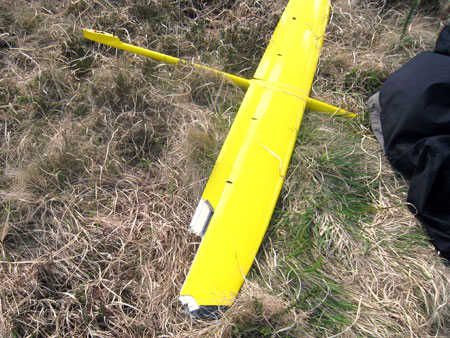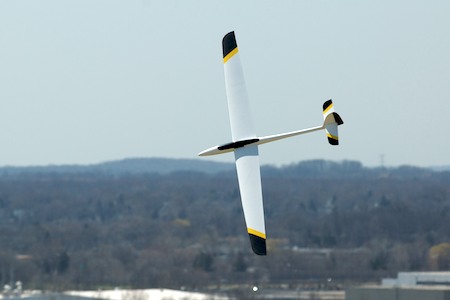Bob sent in this report on his experiences attempthing the 8 hour, Level V LSF slope task.
April 25th 2009. Frankfort, KY.
I responded to an open invitation to go to Frankfort for an 8 hour slope attempt by Gordy Stahl.
I departed Michigan for Frankfort, KY. Arriving that evening with my Oly2 and an AVA.
I thought long and hard about which one to fly. The Oly is great old sailplane but can it penetrate 20+ mile an hour winds? The AVA has a more modern airfoil and is thinner. I decided to try and put “C” batteries in the fuse just below the wing at the CG as Ballast. The batteries weighed 10 Oz. With dense foam rubber and all It weighted about 11 ounces. Not allot of Ballast but enough I thought. The Oly also had 4 “C” cells installed just behind the leading edge bulkhead. So both were available to me.
Last fall I traveled to Frankfort, Michigan to try the 8 hour at a site called Elberta. It is overlooking Lake Michigan. A beautiful location. Landing is A BIT TOUGH BECAUSE OF THE CLIFF CONFIGURATION WITH LOTS OF TREES. LANDING WOULD HAVE TO BE ON THE BEACH BELOW.
The next morning I met with Larry Story and Ted Grosser both are level 5’s, to witness and help me with my first ever slope attempt. When Larry threw my Oly 2 off the cliff my heart was in my mouth.
It basically flew out over the Lake and just parked out there. Not climbing not moving around allot. I thought wow this is going to be easy! NOT! At around the 6.5 hour mark I became very disoriented.. I could not tell up from down and had a hard time keeping the plane pointed the right direction. I kept turning back towards the slope. Larry explained it was the transparent yellow Monocoat that was causing this. I had planned to recover it in Opaque Monocoat but Did not have the time before departing for Kentucky. So I took blue painters tape and covered the bottom of the wing. Yes it was heavy but I thought that would help. The attempt ended at 7.5 hours. I lost altitude and was unable to recover.
This year, on the morning of April 25th, I met Gordy, Little Lee and Ed Wilson LSF V.P. I had decided to go with the AVA. I have two AVA’s one with blue tips and a spoiler center panel One with purple tips and a flapped center panel.
We started hand launching to Trim it out. I had the transmitter on the wrong model. It was on the spoiler panel. Even the rudder servo was working the wrong direction.
After about 6 launches it was ready to go.
At 07:50 Gordy threw it up and out over the cliff. Need less to say it was away, working close to the cliff rim in a figure 8 pattern. It went up with ease.
Gordy launched his Marauder at 8:00. We both are in the air now.The AVA moved around without any effort. I could fly it in any direction. I had made the right choice. It flew very well.
They say only Mad Dog’s and Englishmen sit and stare at the sun. I’m not English….
But for 8 hours? Without any sun blocker? The Mad dog scenario seems to fit well.
Landing at this slope site is wonderful with over 10 acres of grass and a few clumps of trees.
Before it was over more RC slope flyers showed up. The sky was alive with Small little crafts looking like BATS!
I was sitting with Ed Wilson to my right. My butt was fast growing to my chair. Ed had to help me get up to stretch and see if my legs still worked. I was wobbly for the first two minuets each time. I was able to walk to my car for a pee break. It wasn’t to hard to fly and work the plumping one handed. No my shoes are not yellow!
I must say It would not have been doable for me without Ed. He helped me in everyway possible, even putting cold cans of pop on old tired neck, Man did that feel good.
The lift was really good with some thermals working their way thru. At times I was so high that was afraid to blink. Gordy told me once to get it down form there, I listen when he speaks.
So here I am staring into the sun. Bats flying all over the place and I saw something very unusual a meteorite came flying down brighter then hell! It burned out before my very eyes! Was this a sign? Who knows? I have never seen a meteor in broad daylight.
Seven hours down one to go! I am now mumbling to my self and yes answering…Delusional? maybe.
At about 8 minutes to go Gordy got distracted and lost his plane. How this happened is not clear to me…or I’ll never say. But his plane crashed on the slope. 8 Minuets short! A very sick feeling came over me, It was sad.
At 4:00 pm I landed. It was not graceful. It was very fast and I lawn darted it. Not real bad and no damage.
It was over! I would have been much happier if Gordy had not crashed.
Gordy tried it again the next day with A supper AVA and batteries installed as I had done. He made it! It wasn’t as easy Sunday because the lift was much weaker, None the less He did it! Over 16 hours of slope flying in two consecutive days, It has to be a world record!
Bob Summers
LSF 3548 IV



